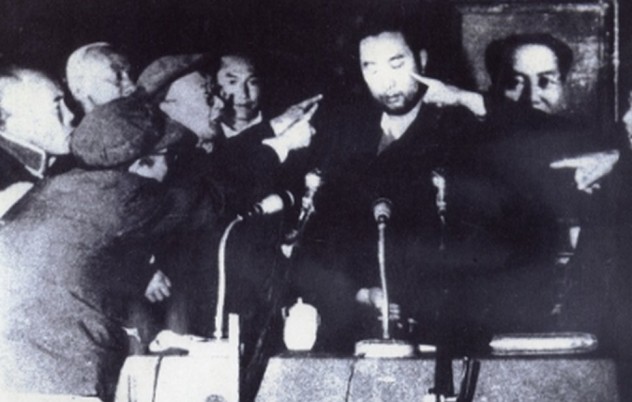However, the idea of brainwashing has always been controversial. Hunter was associated with the intelligence community and it has been suggested that the CIA promoted the term as an easy way to explain away the rapid growth of Communism at the time. The psychologists Robert Lifton and Edgar Schein concluded that American POWs who made anti-American statements mostly did so to avoid physical punishment, and that brainwashing of POWs was not particularly successful. It is thus important to be aware that there is some debate as to what exactly constitutes brainwashing and how effective it can be.
10Chanting And Singing
The act of chanting mantras is an important feature of many religions, especially Buddhism and Hinduism, and almost every church has some sort of hymn-singing worship. As every member of the congregation chants or sings the same words, their voices combining into one chorus, a strong feeling of oneness and group identity forms. This, along with known effects of singing like lowered heart rate and relaxation, might cast the group worship experience in a positive light. But in cults the persistent repetition of short intonations is designed to become mind-numbing, eliminating logical thinking and inducing a trance state. Heightened suggestibility is a feature of such a state, and failure to maintain the trance is often followed by cult-inflicted punishment, ensuring that ultra-conformist behavior is continually enforced. Psychologists Linda Dubrow-Marshall and Steve Eichel have studied how “being subjected to repeated and prolonged hypnotic inductions can impair the convert’s ability to make decisions and evaluate new information,” adding that “continuous lectures, singing and chanting are employed by most cults, and serve to alter awareness.” In this way, hypnosis through chanting is a tool used by cult leaders to erode critical thinking abilities rather than for meditative purposes.
9Isolation
In 1977, Jim Jones and around 1,000 members of his People’s Temple religious group moved to an isolated commune in Guyana. Some 400 kilometers (250 mi) of jungle separated them from the US Embassy in the Guyanese capital Georgetown. As Edward Cromarty points out, such isolation helped the cultists to “lose focus on the values of the outside world,” leaving Jones free to instill his own terrifying regime. Those who questioned Jones would be put into drug-induced comas or even have pythons wrapped around their necks. Rebellious children were lowered into wells at night. The cult’s geographical isolation was thus paralleled by a mental one. Far from the influence of their friends and family in the USA, with brutal punishment awaiting them if they failed to conform, the members of the People’s Temple had little choice but to mutely follow Jones’s poisonous ideologies, even if they were inwardly uncomfortable with what was happening. In its total control over its members and enforced isolation, the People’s Temple Agricultural Project bears comparison with pariah states like North Korea or pre-1991 Albania.
8Dependency And Fear
The 1974 abduction of heiress Patty Hearst by the Symbionese Liberation Army is a classic example of brainwashing via dependency and fear. Hearst was quickly transformed from a young socialite into a bank robber and apparently committed member of a terrorist organization. After she was captured, Hearst was locked in a cabinet and physically and sexually abused, while being repeatedly told that she might be killed at any time. The SLA had total control over her life. This dependence on her captors led to the well-known effect of capture-bonding, or Stockholm Syndrome. Months later, she emerged as an ideologically devoted member of the organization, even participating in the robbery of a San Francisco bank. After Hearst was captured by the police, the prosecution refused to acknowledge her brainwashing and argued that she was fully compliant with the terrorists. She was thus sentenced to seven years in prison. However, President Carter commuted her sentence after two years on grounds of the “degrading experiences” that she suffered as a prisoner. Although Hearst may have been more impressionable than most, her story is a testament to the way that distressing experiences can transform who we are and what we believe in.
7Activity Pedagogy
How does a teacher encourage good behavior and conformism from their students? The answer often involves integrating some kind of physical activity or sport into their teaching. Absorbed in jumping on the spot or running around, and tired as a result, children are less likely to argue or make trouble. Recognizing this phenomenon, several cults have aimed to occupy members with endless series of tiring activities as a means of control. For example, some suspected cults like Dahn Yoga are on the surface just physical exercise systems. In Russia, mass sporting events like calisthenics in stadiums were a recognizable feature of the Soviet system, and are associated by historians with the repressive state apparatus. What separates activity pedagogy from mere sports is that a regime or cult will take advantage of the heightened mood and group identity experienced after physical activity to introduce ideological beliefs that might otherwise be met with skepticism. Exhaustion by exercise is yet another way that people’s defenses can be worn away as means of encouraging them to accept questionable ideas.
6Sleep Deprivation And Fatigue
A combination of sensory overload, disorientation, and sleep deprivation crumbles our ability to make good decisions. The multi-level marketing corporation Amway has been accused of depriving its distributors of sleep during weekend-long functions, which feature non-stop lectures running until the early hours of the morning, with only brief interludes during which bands play loud music complete with flashing lights. A cult technique sometimes used in conjunction with sleep deprivation involves instructing members to follow special diets containing low amounts of protein and another important nutrients. As a result, the cult members will always feel tired, rendering them powerless to resist the dictates of cult ideology. On the 20th anniversary of the Aum Shinrikyo sarin nerve gas attack, the Japan Times interviewed a former cult member, who described “eating one meal a day and sleeping a couple of hours each night” while working on an attempt to get the cult’s leader elected to parliament.
5Self-Criticism And Finger-Pointing
During the Korean War, American soldiers captured by the Chinese were subjected to “criticism and self-criticism” sessions in which they had to denounce fellow prisoners, discuss their own faults, and express their insecurities about capitalism and the US. At first, the POWs thought that the sessions were childish. Yet over time, the ongoing process of criticism started to cause them to manifest real doubts about their patriotism and the validity of the war. Psychologist Robert Cialdini would explain the growing anxiety of the prisoners as an effect of the “rule of commitment,” which says that we try to keep our thoughts consistent with our public statements, since we do not like to be erratic or dishonest. Despite some limited successes, the Korean War “brainwashing” methods were not particularly effective overall. Only 23 POWs refused repatriation at the end of the war and the Chinese had mostly abandoned the reeducation sessions a year before the war ended. However, they continued to use similar practices domestically. The Tibetan Panchen Lama is pictured above during one such session of public abuse in 1964.
4Love Bombing
Cults wish to reinforce the impression that the world outside the group is threatening and gravely in error. To make themselves appear welcoming in contrast they often employ “love bombing” to makes themselves appear welcoming in contrast. Love bombing involves showering new or potential recruits with lavish and demonstrations of attention and affection. The term probably originated with either the Children of God or the Unification Church, but can now be applied to a number of different organizations. It is a commonplace of social psychology that we feel strongly inclined to reciprocate the kind behavior and generosity of others, so the feigned love, encouragement, and friendship shown by established cult members towards initiates is designed to create an increasing sense of obligation, debt, and guilt. Margaret Singer called this a key feature of cults, effective because companionship and validation are precisely what many new cult recruits are looking for. The psychologist Edgar Schein argues that people are initiated into cults through a process of “unfreezing and refreezing.” During the unfreezing stage, a potential new cult member begins to reject his old world view and becomes open to the cult’s ideas. During refreezing, the cult solidifies this new outlook. Schein points to love bombing as a key element of refreezing—recruits who accept cult philosophy are rewarded with hugs and compliments, but are shunned if they ask too many skeptical questions.
3Mystical Manipulation
Psychiatrist Robert Jay Lifton argues that many cults rely on “mystical manipulation” to achieve total control of their followers. Mystical manipulation refers to the control of circumstances or information by cult leaders to convey the impression that they command supernatural wisdom, divine favor, or magical powers. In other words, purported religious leaders promote themselves as God’s infallible messenger, whose opinion must always be true and right, and support this via stunning tricks and extraordinary gimmicks. George Roden, one of David Koresh’s early challengers for the leadership of the Branch Davidians, theatrically exhumed a corpse, which he pledged to return to life to prove his necromantic powers. He challenged his rival to do the same, but Koresh simply reported him to the police for grave robbery instead. The police asked Koresh for proof and a gunfight ensued when Koresh’s faction tried to gain entry to the compound where Roden was keeping the corpse. Koresh himself was actually known as Vernon Howell at the time, but later changed his name to suggest descent from the biblical King David. He adopted the last name Koresh after Cyrus the Great, a Persian king who freed the Jews from Babylonian Captivity. Koresh created a messianic persona and encouraged his followers to attribute unusual experiences to divine intervention when he, in fact, had orchestrated them.
2Barratrous Abuse
Many cults employ lawyers to sue anybody who publicly criticizes them, no matter how trivial the criticism. Of course, the cults can usually afford to lose the lawsuits, whereas ex-cult members are often insolvent after giving their lives to the organization. Many ex-cultists are therefore in no position to mount an effective legal counterattack. Moreover, mainstream journalists are scared to condemn cults or cite cult material, due to the ever-present threat of legal action. In 2003, investigator Rick Ross obtained excerpts from the manuals of NXIVM, a self-improvement organization accused of cult-like activities. Ross put the excerpts online, only to be hit with lawsuits and investigators rifling through his trash. A number NXIVM employees who have left the organization have faced hefty lawsuits. A judge dismissed one such case, noting that the employee in question had merely attempted to leave, only to be “labeled as ‘suppressive,’ a term that NXIVM applies to former associates who leave the company or whom NXIVM perceives to be its enemies, and subjected to protracted litigation from two large law firms and a phalanx of attorneys.” Scientology is also famous for using frivolous lawsuits to discourage opposition. L. Ron Hubbard wrote in 1967 that “we do not find critics of Scientology who do not have criminal pasts” and that lawsuits should be used to silence these inherently guilty critics. “The purpose of the [lawsuit] is to harass and discourage rather than win.” Well aware of the consequences of upsetting Scientologists, HBO preemptively hired 160 lawyers to defend their 2015 documentary Going Clear. Deterred from striking back in the courts, the church mounted a “brutal” campaign against people who appeared in the film and director Alex Gibney.
1Thought-Terminating Clichés
Another important concept advanced by Robert Jay Lifton is the idea that totalitarian regimes are often reliant on “thought-terminating clichés” to enforce conformity on their subjects. Through these clichés “the most far-reaching and complex of human problems are compressed into brief, highly reductive, definitive-sounding phrases.” Lifton’s classic example was the “all-encompassing jargon” of Communist regimes like China and the Soviet Union, where language became “abstract, highly categorical, relentlessly judging” and ultimately “the language of non-thought.” The Soviet Union’s love of this kind of jargon earlier inspired George Orwell’s novel 1984, in which the oppressive government designs a language called “Newspeak” with the goal of suppressing the ability to think except in terms defined by the state. Modern non-state groups like the Church of Scientology might be considered to have developed a set of phrases roughly equivalent to Soviet jargon. The most famous example of “thought-terminating clichés” probably comes from the trial of Nazi official Adolf Eichmann. In her famous book on Eichmann and the “banality of evil,” the writer Hannah Arendt noted that the SS leader frequently spoke in stock phrases and clichés. Eichmann repeated that he wanted “to make peace with his former enemies,” but Arendt concluded that the phrase was meaningless because he didn’t understand the magnitude of his crimes at all—he could only conceive of them in the language of National Socialism. Arendt concluded that the wartime “German society of eighty million people had been shielded against reality and factuality by exactly the same means, the same self-deception, lies, and stupidity.” George investigates abuses of authority, and surfs on Australian beaches.
























